2. Americans Old and new.
This class continues and contextualizes the opening theme of the course: the impact of European operetta on Broadway. The three composers
above arrived in this country at the end of the nineteenth century (Herbert) or the beginning of the twentieth (Friml and Romberg).
Although they each wrote musicals of other kinds, their legacy includes works like the three shown here, all set in fictionalized
lands of royalty and romance.
But there was a Broadway before these three arrived—or rather, a number of musical shows playing downtown, even before the theaters
moved up to the 42nd Street area to create the Broadway we know today. Our first hour offers a rapid survey of some of these,
necessarily brief because none of the shows were filmed at the time and we have to make do with reconstructions. But they should be
enough to show something of the range of popular musical work created by Americans for Americans in America. rb.
The script, videos, and images will be posted immediately after class.
Q AND A
Did all the movie actors do their own singing?
Apparently so, with the single exception of Edmund Purdom in The Student Prince, lip-synching to Mario Lanza, who recorded the sound track but was removed from the show. William Olvis, who sang the title role in the Student Prince Serenade clip, was an operatic tenor who also sang at the Met; his son became a Hollywood composer.
Who wrote the lyrics for Romberg's "It"?
The lyricists of record for The Desert Song in which "It" first appeared are Otto Harbach and Oscar Hammerstein II. "It" was an interpolated number, however, with lyrics by Edward Smith, whose other work I don't know at all. It beautifully supports my point, however, that the cleverness of the words in American musicals gained a sophistication in the early 20th century sooner than similar developments in the music. [There was a typo (not mine) in the titles: the word "It" as a term for sex appeal was popularized by Eleanor Glyn, not "Glen."]
Are there any differences between European and American operetta?
David, one of our class members, suggested that European operetta is more formal. American operetta, he thought, shook off the bonds a bit, let itself go. I thought this this was worth pondering, and am pondering it still. In the long run, sure: American musicals generally move out of the ballroom into the street (though they can always be seduced by glamor). But as David himself suggested in a later letter, part of this might be due to the examples I was able to obtain. Die Fledermaus and The Merry Widow were performed by opera singers in elaborate productions, hence somewhat formally; the various clips in last week's class ran the gamut in terms of professionalism and budget.
What happened to In Dahomey by Will Marion Cook?
There may be references here and there to early musicals written and performed by Black artists. But I removed this section at the last moment for lack of time, and will be dealing with it at slightly greater length next week.
VIDEO LINKS
Miraculously, all the videos played in class can be seen on YouTube in some form. All the links below are cued
to where we started, but many of them are considerably longer. rb.
| |
|
|
|
|
|
| IMAGES |
The thumbnails below cover the slides shown in class, though
there may be a few small discrepancies. Click the thumbnail to see a larger image.
Click on the right
or left of the larger picture to go forward or back, or outside it to close. |
 | |
 | |
 | |
 | |
 | |
 | |
 | |
 | |
 | |
 | |
 | |
 | |
Here are brief bios of the artists, composers, and writers considered in the class, listed in order of birth.
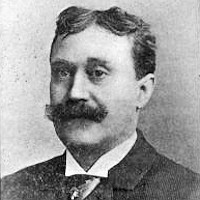 |
Edward Everett Rice, 1847–1924. American composer.
Rice's musical training enabled him to play fluently by ear, but he never learned to read music. When his father offered to send him to Germany to rectify this, his was dissuaded by an organist friend, saying that the public needs more songs, not sonatas. And songs he gave them, whether in his own musicals like Evangeline (1874) or the numerous works he produced by others, including the first all-Black shows on Broadway.
|
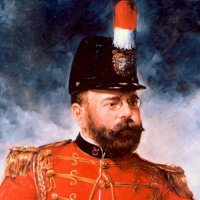 |
John Philip Sousa, 1854–1932. American composer.
Although he started his professional career as a violinist, Sousa is best known composing music for military band. Most of his later life was spent as a canductor and bandmaster, originally with the US Marine Band. He also wrote a number of operettas, one of which, El Capitan, is occasionally revived.
|
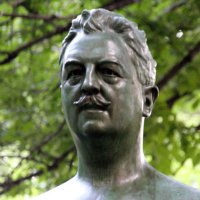 |
Victor Herbert, 1859–1924. British-American composer.
Born in the Channel Islands (though his mother told him Dublin), he went with her to Stuttgart, where he received training in cello and composition, leading to a career as an orchestral player and soloist, often in his own compositions. He came to the US in 1886 as principal cellist at the Met, and became conductor of the Pittsburgh Symphony in 194. His career trajectory changed completely in 1903, however, with the success of Babes in Toyland, the first of his many operettas.
|
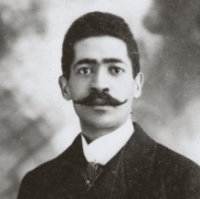 |
Will Marion Cook, 1869–1944. American composer.
Cook's father was Dean of the Law School at Howard University. The son attended Oberlin College, then devoted himself to music, studying with Dvorak in New York and Joachim in Berlin. He was the composer of the first all-Black musicals on Broadway: Clorindy in 1898 and In Dahomey (1903), both with the poet Paul Laurence Dunbar.
|
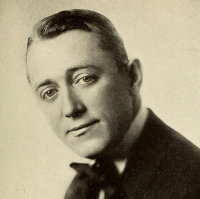 |
George M[ichael] Cohan, 1878–1942. American composer and perfomer.
Although his stage film and career lasted until his death, Cohan established himself before WW1 as "the Man Who Owned Broadway." Starting as a child performing with his parents and sister, he wrote hundreds of Tin Pan Alley songs and several musicals, starting with :Little Johnny Jones in 1904. He was also active as an impresario, producing the work of others. He is played by James Cagney in the 1942 biopic Yankee Doodle Dandy.
|
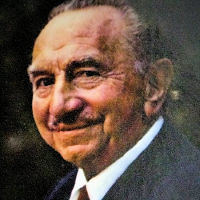 |
Rudolf Friml, 1879–1972. Czech-American composer.
A student of Anton Dvorak in his native Czechoslovakia, Friml came to the US in 1906, after several earlier visits, finding success as a répetiteur at the Metropolitan Opera and performing pianist. But he became best known as the composer of operettas, the best known being Rose Marie (1924) and The Vagabond King (1925), both of which were soon made into films.
|
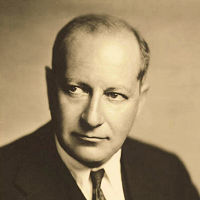 |
Sigmund Romberg, 1887–1951. Hungarian-American composer.
Born Siegmund Rosenberg in Hungary, he showed precocious talent as a musician. He came to America in his late teens, and soon began working for a music publisher, adapting European musicals for US performance. His own most successful shows, The Student Prince (1924) and The Desert Song (1926), were in a similar style, but he could also write music that was entirely American in spirit.
|
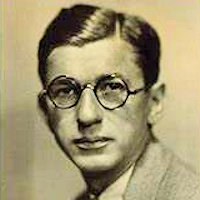 |
Irving Caesar, 1895–1996. American lyricist.
Born Isidor Keiser in NYC, Caesar collaborated with a wide variety of composers and songwriters, including Rudolf Friml, George Gershwin, Sigmund Romberg, and Victor Herbert. His "Tea for Two" in Vincent Youmans' No, No, Nannette became an American Songbook standard. His older brother Arthur was a Hollywood scriptwriter.
|
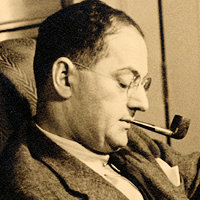 |
Ira Gershwin, 1896–1983. American lyricist.
Ira (Israel) Gershwin is remembered as the lyricist of most of the shows and independent songs of his younger brother George, but he also wrote for Jerome Kern, Kurt Weill, and several other composers. His numbers like as "I Got Rhythm", "Embraceable You", and "Someone to Watch Over Me" have become standards, and his also contributed some of the wittiest lyric to his bother's opera Porgy and Bess.
|
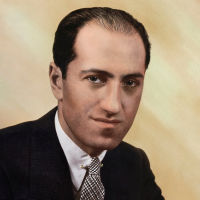 |
George Gershwin, 1898–1937. American composer.
Born Jacob Gershwine in New York to Jewish emigrants from Eastern Europe, he studied piano and composition, but soon found his vocation as a songwriter, mostly with his elder brother Ira (born 1896). Most of his songs have become crossover standards, as have his orchestral works Rhapsody in Blue (1924) and An American in Paris (1928). Most of his stage works are primarily containers for his songs, but his 1935 opera Porgy and Bess is an exception, a closely-developed study of African-American life.
|
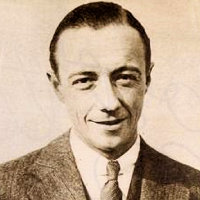 |
Vincent Youmans, 1898–1946. American composer.
Youmans published only around 100 songs in his lifetime, but 18 of these are recognized by ASCAP as standards. He collaborated with lyricists such as Ira Gershwin, Oscar Hammerstein, and Irving Caesar, with whom he wrote No, No, Nannette in 1925, his best-remembered show.
|























